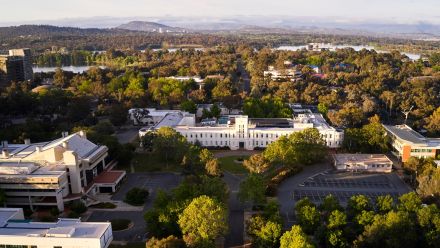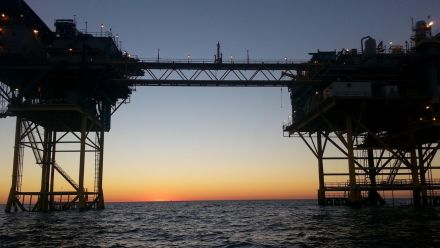Today, ANU reaffirms its commitment to achieve below-zero emissions – a target we now aspire to reach by 2040. Read the full statement and refer to the FAQs below for more information.
Why is ANU committed to achieving below zero?
As the national university, ANU is committed to strong action, speaking publicly and world-class research and teaching on the challenges posed by climate change.
ANU is also committed to lending its world-class research and expertise to help address the challenge emergency and adapt to climate change across our own organisation and operations.
The University is committed to being a leader on this challenge, as well as sharing our expertise and knowledge with other organisations and wider society so that they can meet this challenge too.
What are the University’s revised targets and timelines?
ANU will seek to reach carbon neutrality for our direct on-campus and energy-related emissions (scope 1 and 2) by the end of 2025.
ANU aspires to reach below zero across its operations and supply chain by 2040.
Why is ANU readjusting its below-zero timeline?
ANU is reaffirming its commitment to reaching below zero – albeit with slightly adjusted timeframes due to a range of important sector, operational and financial considerations.
In aiming to reach below zero, ANU seeks to not only draw down emissions through offsets but to abate and reduce emissions across the University’s operations in a manner that does not compromise its core business of teaching and research. The University is prioritising emissions reductions and avoidance first and foremost. Developing robust solutions for this abatement takes time and significant investment.
The decarbonisation landscape has also radically changed since ANU announced its ambitious goal of reaching below zero in 2021. One of the most fundamental changes has been enhanced understanding and knowledge of the effectiveness of carbon offsets, with research from ANU experts showing that to achieve net and below-zero targets, offsets must be high-quality. This research has also helped raise awareness of the inconsistent quality of offsets available in the market, with limitations to the number of available high-quality offsets.
In addition, over the last few years, ANU has faced a series of operating deficits and has enacted appropriate measures to address these financial challenges. The University has a recovery plan in place to return to balance. These ongoing financial constraints will also dictate the pace of the University’s actions as it moves to below zero.
What emissions is ANU targeting?
ANU will initially focus on reducing and offsetting scope 1 and scope 2 emissions from its operations. ANU also commits to continue to map and reduce the University’s scope 3 emissions.
The purchase of offsets will be an important investment to set us on the path toward carbon neutrality from 2025 onwards. We are confident this approach will allow us to achieve carbon neutrality for scope 1 and scope 2 emissions from 2025.
The University will continue to monitor and align our efforts with the emerging definitions and standards in this rapidly evolving space.
What action has ANU taken to reach below zero?
Since setting its ambitious goals in 2021, ANU has achieved much to meet the ambitious targets the University set itself.
ANU has converted seven buildings from gas to electric heating, installed electric car chargers on campus, developed a master plan for decarbonisation across our main campus, developed principles for carbon removal, and developed an inventory of emissions we will aim to eliminate from our operations, among a range of other important initiatives and actions.
ANU deliberately set ambitious targets in 2021 to motivate action. This has been a success. The action inspired by our ambitious targets has not only kick-started meaningful change on our campus and across our operations but enriched our understanding of the path to below zero, and how we can get there in a way that offers meaningful, sustainable and responsible change.
The University is proud of this work and the solid foundation it has provided in making sure ANU can achieve below zero by 2040.
What actions will ANU explore to reach below zero by 2040?
The University is already exploring multiple initiatives to help reach our carbon neutrality and below zero targets.
This includes:
- Exploring lower emission travel options for all staff and in ways that do not impact the University’s core business of research and teaching.
- Investigating waste collection options and piloting food organic/green organic waste collection across the ANU campus.
- Exploring opportunities to commercialise decarbonisation technology and research that is undertaken across ANU to help reduce emissions across our society and economy.
- Exploring the University’s carbon removal principles and working with our academics to identify and leverage novel carbon removal processes. This includes purchasing high-quality offsets and increasing the quality of offsets purchased by ANU each year.
What’s the difference between carbon neutrality and net zero?
Carbon neutrality and net zero refer to actions that help combat climate change.
Carbon neutrality applies to defined business operations to help reduce and remove carbon emissions.
Net zero refers to actions to reduce all greenhouse gas emissions across an organisation’s operations.
ANU is focusing on achieving carbon neutrality from 2025 across all scope 1 and scope 2 emissions.
Why is ANU seeking to reach below zero via carbon neutrality?
When ANU set its targets in 2021, net zero was also not defined by any leading or authoritative third party. It has now been defined and this definition has provided ANU with greater clarity on how it can best achieve the path to below zero in an operationally, environmentally and economically sustainable manner.
Why isn’t ANU just buying offsets to reach net and below zero?
The University’s priority to reach below zero is abatement and removing as many carbon emissions from its operations through direct action.
The University will use select offsets to help reach carbon neutrality from 2025 across all scope 1 and scope 2 emissions.
In line with the University’s principles, ANU is committed to ensuring that any purchased offsets are of the highest quality possible in the available market and will affect meaningful change for the better. Identifying and purchasing these types of offsets takes time and significant financial investment.
Is ANU abandoning its below-zero aspirations?
Not at all. ANU remains steadfast in its commitment to reach below zero.
Our revised timeline will ensure the University achieves this ambitious goal in a manner that affects long-term and meaningful change, and in a way that also aligns with the University’s core operations, its values and its commitment to environmental sustainability.
The imperative to act on climate change is only getting stronger. ANU is not only recommitting to but expanding our ambitions when it comes to reducing emissions.
It will take time to develop mitigation strategies for all our emissions – but that is our long-term goal.


